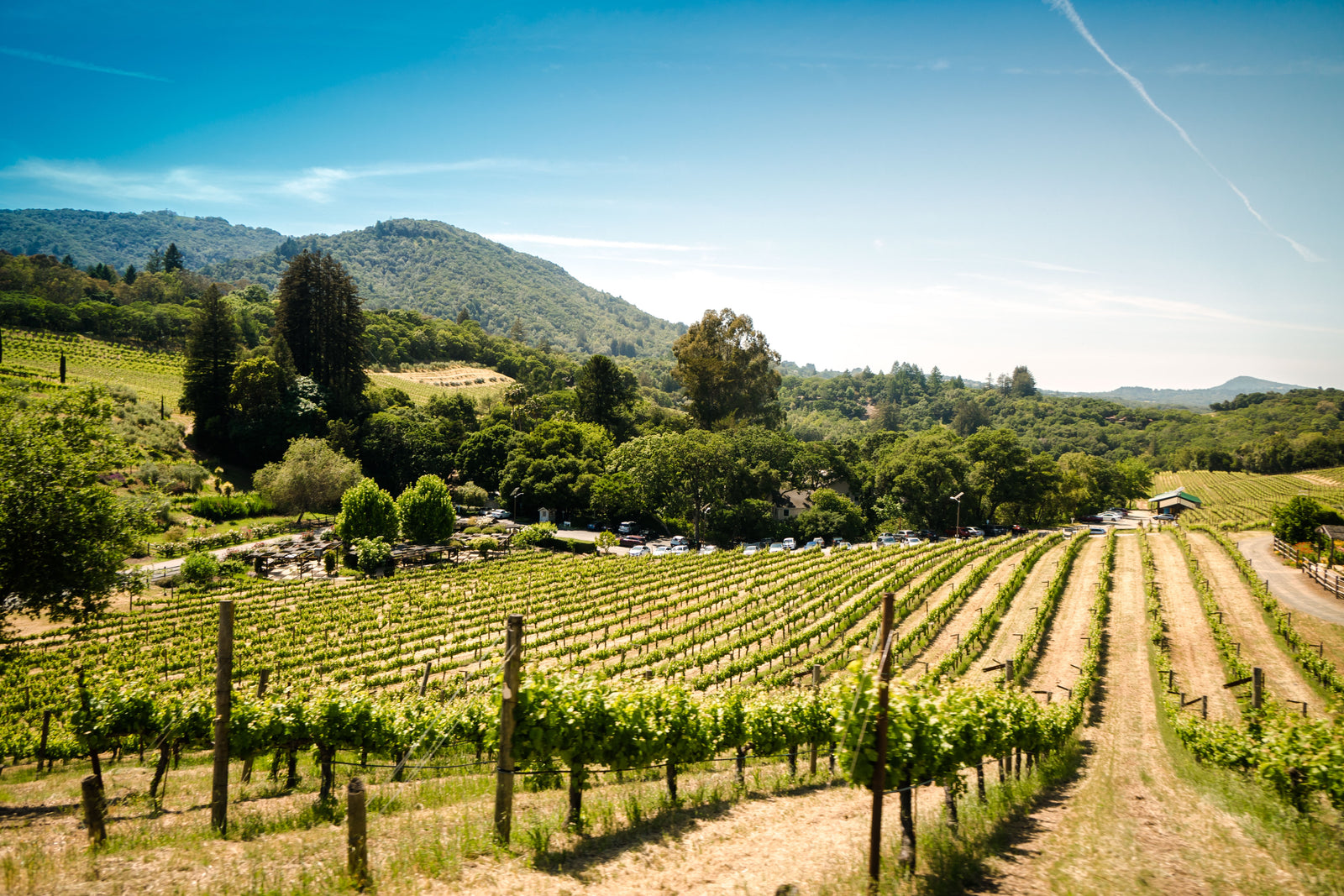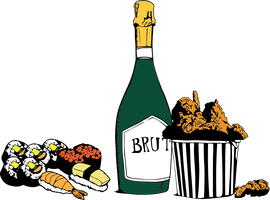Sonoma County, as a wine region, exhibits a greater assortment of wine styles and grapes than you find in most other premium wine areas. From the highly regarded Chardonnays and Pinot Noirs of the Russian River Valley and Sonoma Coast, to the flavorful Zinfandels and Cabernet Sauvignons of the Alexander, Dry Creek and Sonoma Valleys, Sonoma County’s range of terroirs is second to none. It has been said that Sonoma County has more soil types than in all of France. The region’s dramatic geological history has resulted in 11 major formation types, 31 different soil series within those types, and innumerable permutations within each series. This diversity of geography has resulted in 18 recognized AVAs (American Viticultural Areas), ensuring individualism of wines and a wide variety of farming practices. Sonoma County’s vineyards range from sea level to 2,600 feet above sea level, and the array of valley, benchland, and mountain elevations and slopes heavily influence soil fertility and grape ripening times. The county is blessed with an ideal long growing season, with sunny days and almost no rain from May through September. The Pacific Ocean provides a cooling maritime influence, bringing cool air through the Petaluma Gap, Russian River, and San Pablo Bay entry points that cool the western and southern regions of Sonoma County. The daily summer fog patterns are ideal for cool climate varieties. In other words, a great place to make wine!
Almost 200 years ago, Russian colonists planted what are believed to be the earliest-known wine grapes in Sonoma County. Any grape-growing influence they may have had was very short-lived because in 1841 they were forced from Fort Ross, which they had founded in 1812. But their agricultural influence inland from Fort Ross served as the foundation for today’s Russian River Valley. Meanwhile, the padres, who were building missions throughout California, planted rows upon rows of vineyards in 1824 at their northernmost site, San Francisco Solano, in order to produce sacramental wine. Agoston Haraszthy, a Hungarian nobleman, arrived in Sonoma Valley and purchased the Salvador Vallejo vineyard in 1855, bestowing on it a new name, Buena Vista. Today it is the oldest functioning winery in California. According to legend, Haraszthy quickly became a key figure in the California wine industry. Commissioned by the state legislature to study European viticulture overseas in 1861, he returned to Sonoma County a year later with more than 100,000 cuttings of about 350 prized grape varieties from France, Germany, Italy and Spain. When the state wouldn’t reimburse him for his trip, he was forced to plant, cultivate or sell the cuttings on his own. He wound up planting many within the county, dramatically increasing its wine grape acreage. He also experimented with innovative grape-growing techniques that he learned while overseas, including planting rows closer together and on hillsides.
The primary objective of Carpenter Wines is to make wines that speak of place rather than process, and that place happens to be Sonoma County. Jake Hawke and Laura Carpenter-Hawke believe “the creative process is about taking chances, making mistakes, and learning from them. The first order of business as a winemaker is to make wines that are compelling, not wines that are flawless.”
The Hawkes Family has been growing grapes in the Alexander Valley since 1972, twelve years before Alexander Valley was an appellation. Healdsburg was prune country, a town square, and a few cowboys back then. In 2002, the family began making single-vineyard Cabernet Sauvignon, when Jake (born and raised in Sonoma County) convinced his dad to diversify the family business and start making wine from the vineyards they’d been farming for 30 years. Laura Carpenter Hawkes arrived in San Francisco in 1993 after growing up on the East Coast. She toyed with wine interests with trips to Sonoma, a tutelage in the Whole Foods wine department, helped launch the Liberty Cafe, then spent a year in Italy. Upon her return, she managed Solano Cellars in Berkeley and did a stint in Austin, Texas, working for Horizon Wines.
Ultimately, she returned to Sonoma to make wine with family. In 2012, 40 years after the Hawkes family had planted their first vineyards, Laura and Jake started Carpenter as a way of departing from what they knew. Jake had been making Chardonnay since high school, but they wanted to make Pinot Noir, and they wanted to do it on their own terms. Carpenter Chardonnay and Pinot Noir are produced in very small quantities and are not only unique because of the vineyards they originate from, but also due to their clonal selections and winemaking techniques. Our selections this month truly showcase how a wine’s taste reflects everything that goes into its making.
Carpenter Stone Vineyard Chardonnay 2018
Initially the Carpenter’s Chardonnay was a single-vineyard Chardonnay sourced exclusively from the Gravel Bar Block of the Hawkes’ Stone Vineyard on Chalk Hill Road, planted by the family in 1972. The ranch is a tiny, self-contained valley at the border of the Alexander and Russian River Valleys, totaling about forty acres of vines. The ten acres of Chardonnay grow along the Maacama Creek, a tributary of the Russian River. The Gravel Bar Block is named for the remains of an extinct creek that cuts across the eastern half of the Chardonnay field. Jake says, “Our Chardonnay always picks in the second week of September. That's pretty late for Chardonnay in Alexander Valley, but Stone is a very cold vineyard. Let's call it the coldest vineyard in Alexander Valley. I think that’s safe to say.”. Today, the Carpenter Chardonnay comes from two different blocks, the Gravel Bar Block, which is almost all small, round stones, and the other block (which doesn't have a name) and has more organic matter. Once the grapes are harvested 40% of the wine goes through malolactic fermentation. The wine is then aged in neutral French oak barrels for 5 months on the lees, with regular battonage (stirring). The result is an appealing brioche-like aroma, a creamy texture, and complex and balanced fruit flavors. From the winemaker, “Our Chardonnay is a gift. I just try not to f**k it up. You'll get everything from wet stone to all kinds of green aromatics and flavors, plus citrus, lychee, guava, etc. I get lemongrass on the regular in this wine. Its time in barrel and a percentage of secondary fermentation add to these layers. Building this wine is like making filo - delicate layer upon delicate layer - take a light hand.”
Straightforward, rich, and complex, the 2018 Carpenter Chardonnay has an intensity of fruit and a hint of minerality which allows it to pair with noble crustaceans (king prawns, lobster, crawfish), rich fish dishes such as salmon or monkfish, as well as foie gras. With acidity and smoothness so nicely in balance, it goes well with white meats such as veal or poultry in cream sauce, as well as many varieties of mild cheeses. Its aromatic power means it can also match spicy and perfumed exotic dishes such as couscous, fish tajines, or sweet-and-sour prawns.
Carpenter 2018 Chardonnay is $29.00/bottle, $313.20/case.
Carpenter Sonoma Coast Old Road #3 Pinot Noir 2017
2017 Carpenter Sonoma Coast “Old Road #3” Pinot Noir is made from a vineyard site that is dual-appellation Petaluma Gap and Sonoma Coast. Jake and Laura said, “Starting in 2012, we produced Pinot Noir from a number of different sites in Russian River Valley and the Sonoma Coast. We sent those wines to barrel, tasting them over the next 10 months or so, and settled on the Old Road #3 Vineyard, owned and operated by the Flocchini family, as the sole source for our first vintage of Sonoma Coast Pinot Noir.” The Flocchini Ranch, 150 acres in total, was purchased by Frank Flocchini in 1918 and was a working dairy farm until 2002, when Andrew Flocchini and his brothers planted 30 acres of Syrah, Chardonnay, and Pinot Noir there. Today, the Flocchini’s 16 acres of Pinot Noir are planted to five different clones: 337, Swan, La Tache, Pommard, and 777. There's a near-constant breeze here, which causes the berries to be smaller than they otherwise would be and generally stresses the vines. That breeze comes directly from the Pacific Ocean, and has a constant cooling effect on this vineyard, as does the presence of the nearby San Pablo Bay.
The 2017 Sonoma Coast Pinot is primarily a co-fermentation of three clones (Swan, Pommard, and La Tâche) and happens in a stainless tank. It gets about 48 hours of cold soak prior to fermentation, which is good for extracting color and a dark-sweet fruit component. The native yeast ferments are cool and slow and give more delicate herb and flower aromatics. A very small portion of the Pinot Noir is fermented in 3/4 ton open-top tanks so that they can keep each of the three clones completely separate. This enables them to study each clone’s evolution and change over time, and 3/4 ton open-top tanks also allow punch downs by hand. For the 2017 Jake wrote, “There's a cold, mossy element to all three clones we make from Old Road #3, particularly the Pommard, which is dominated by a brooding, introverted host of aromatics: bramble, forest floor, mushroom. Even in the Swan clone, which is considerably more high-tone than the Pommard, a certain darkness tinges the wings of red fruit. This is what cold and proximity to the sea can do for Pinot Noir: give it edge and dimension. In the riper vintages, including 2017, I have opted to get the wine in the bottle as soon as possible. I think riper Pinot tends to have less of the dried rose petal and jasmine and mint to begin with. Leaving it in the barrel for too long lets that stuff get away.” The nose of the 2017 Carpenter Pinot is full and rich, with intense aromas of spices, dried mushrooms, and black plums. Juicy and spicy, with a velvety texture, the wine fills the palate, hitting all the notes: bitter, salty, sweet, acidic, and umami-esque. The will pair beautifully dishes such as Pan-seared salmon with beurre rouge, prosciutto pizzetta with sunny-side-up egg, roasted duck, game birds, mushroom dishes, pork and poultry.
Carpenter 2018 Sonoma Coast Pinot Noir is $29.00/bottle, $313.20/case.





